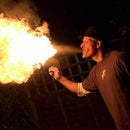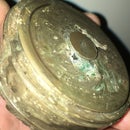Introduction: 5 Cool Tricks of Science at Home
Science has to one of my biggest passions, and this instructable is about some of simple curiosities that I find interesting and that have been extensively researched by classical scholars all over the world from the when science was in its infancy to present day. All of these tricks of science can be found in most classrooms and text books.
Why do I like science, well, it's a broad subject, a subject of controversy, wonder, without it we would still be in the stone-age, it's taken for granted so much so that its in every part of our life and we would find it hard living without it.
The discoveries we have made over the last century are profound. I just hope that with all this knowledge and understanding, that we more become more responsible for the earth in which we live for now and future generations.
I will now present 5 Fun with the family - you can do at home Tricks Of Science only one of these will need supervision for younger age groups...........
Step 1: Fire Extinguisher in a Glass & Flame Again Please
First of all, the basis of the trick....... When the candle is lit with a flame' the wick burns and allows molten wax ( Hydrocarbon) to be drawn upwards to the flame. The liquid then becomes a combustible vapour as it mixes with the surrounding oxygen, which is then self sustaining until the fuel is exhausted.
If you watch both videos below, you will see the proof of the claim above. By blowing the flame out, the smoke can be re-ignited without lighting the wick. (Flame Again Please).......
The combustion products are the points of interest here....! A hydrocarbon is a name given to most substances that are flammable/ combustible and derived from crude oil. Methane CH4 is the simplest hydrocarbon, as the number of Carbon-Carbon bonds increase so do the Hydrogens = HrydroCarbon...... When hydrocarbons mix with Oxygen and combust, you end up with [H2O & CO2]' CO2 is what we will be studying......
Like a candle, when we eat food and burn the energy we produce Heat, Water in the form of sweat (H2O) and we breathe out (CO2) Carbon dioxide.
***Carbon Dioxide is very interesting and where this instructable starts------> if we take 2 half-pint glasses or something similar in measure - then place 1 lit T-light candle inside one of them. See images (2-4,5,6,) .***
In the other glass we now prepare the Carbon Dioxide Gas - just pour a little vinegar about a couple of inches worth in the bottom of the empty glass then taking a level tea-spoon of bicarbonate ( this will effervesce, cover with coaster or your palm, whilst neutralisation is occurring) See images (7-10)
When relation has stabilised un-cover, then take glass as in image (11) place glass very close the glass with burning candle in it and pour slowly (Without Pouring Any Liquid).
Now before your eyes the candle should be extinguished!!!!! -
Mechanism----> Carbon dioxide is heavier than air and when the vinegar & bicarb was fizzing away - the water and carbon dioxide were being produced, The Empty Portion of the glass was invisible carbon dioxide gas.
Like a fire We Need Oxygen to carry on burning our fuel and Carbon dioxide does not support Combustion.
>>>>>>This is why we have co2 fire extinguishers.<<<<<<.............
If you re-light the candle and place a mat over the top, it will go out also, because the remaing oxygen is converted in the combustion process to CO2 which starves the candle of Oxygen......
Enjoy
Attachments
Step 2: Twin-Combs, What's Going on Here?
What we have here, is a visual illusion of how we see things in stereo and our brain interlaces (combines) the two images together. Nets and Screens are very interesting, apart from their geometry, they can produce an interesting behaviour on our visual cortex, especially if we alter their angle to each other when interweaving them (Moiré Affect).
This causes a variety of patterns and a great deal of movement, similar to how early animation and television work. There are many examples on the web in YouTube of things moving like clockwork - a truly fantastic illusion. If you look at image (1-2) this is taken from my net-curtains - the picture does not give it justice as its a sunny day, but it gives you an idea. Images (3-11) give you subtle changes when proximity and angle are altered.
If you take a comb in both hands a little distance away from your eyes and then overlay them parallel, some distance apart you will notice a cross-hatch pattern, then slightly rotate them angles slowly or pull and push them to generate the patterns above. Have Fun!!!!!! More fun to follow ----->
Attachments
Step 3: Triboelectric & Static Electricity
This instructable is very fun indeed - again we are utilising our comb from the last chapter, why you may ask, well it is a really useful object to have on one's person when you know of other uses for it...... The comb is made from what we call a kind of dielectric-material (plastic) most likely to be a nylon or something similar.
The thing about this material is it can be charged very easily especially with ones hair or wool. Interestingly enough if you washed your hair the day before and did not put a product in it you can start charging the comb. Believe it or not Van de graaff generators have 2 Combs one to the bottom (earth) ------ and one to the top ++++++ and this is how the charge is built up. In our instructable we will only be using one comb-------->>>>>>>
Take a piece of kitchen or toilet paper, use only one of the layers and cut with scissors into 8mm squares. Take the comb and comb your hair, now place the comb in close proximity to the paper and the paper will jump to the comb........ Wicked!!!!
Why does this happen, well different materials have different charge potentials. From the list below we see the Order of potential from the list of the Triboelectric Series. The polarity depends on which materials are paired whether one is positive and the other negative.
The list starts Positive and becomes more Negative as it descends. (Your Hand, Glass Rod, Your Hair, Nylon (Our Comb), Wool, Fur, Silk, Paper, Cotton, Rubber, Polyester, PVC,)
So we are charging the Nylon comb from our Hair then we are attracting the Paper Coooooooollllllll.....!
Attachments
Step 4: Bending Water
Another popular science trick is (Bending Water) this is because water is a dipole - what is a dipole? A dipole is a polar field, akin to a magnetic field but the symmetry is biased towards one polarity or let's say heavy on one side......with water it gives it elastic properties, because the individual molecules of water are attracted like so ++->, ++->,++-> and so on.
The 2 Hydrogens on the water molecule (H-O-H) are both ++ the Oxygen however is Negative and more so than the 2 Hydrogens put to together - This means it's negatively biased because of Oxygen.
***Now to perform this trick, we turn on the tap, so a small gentle stream of flowing water comes out .See image (3) Then we take our comb like in the previous instructable and put a charge on it by combing our hair. Now we place the comb in close proximity to the water stream and watch the water bend. See image 2 and watch the video. ***
Mechanism is like the previous experiment the charge on the comb attracts a charge on the water drawing it towards the comb.
I hope you liked my take of these mini scientific experiments........Please rate and comment, any feedback is welcome ;-D..................I G





